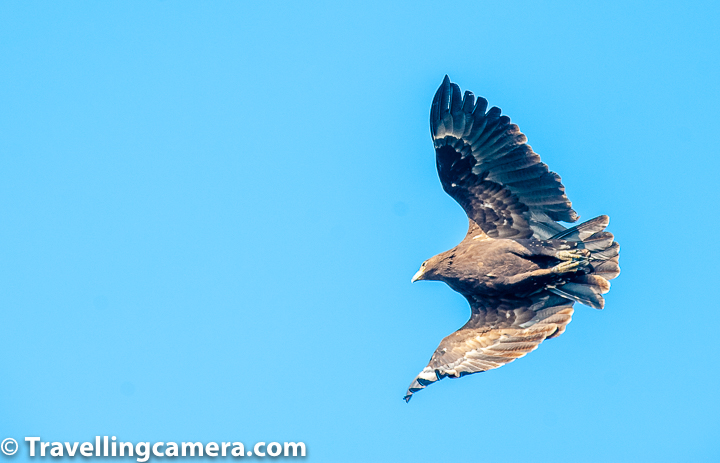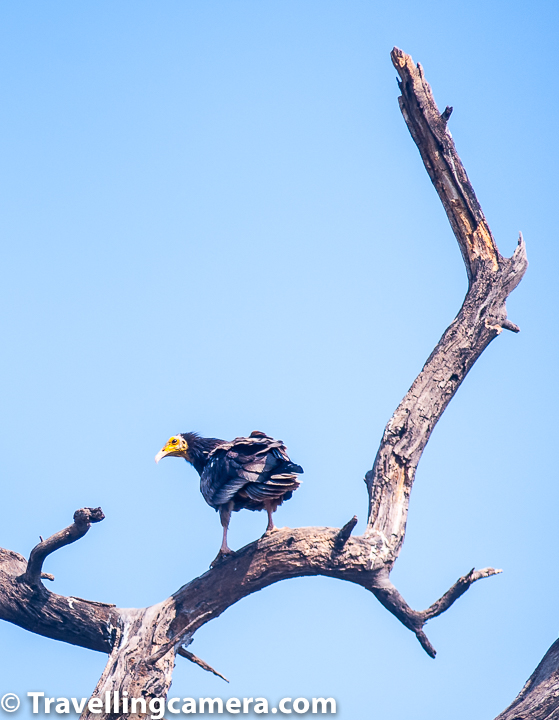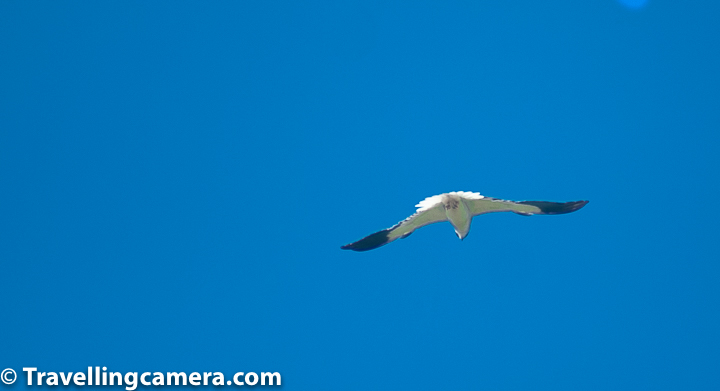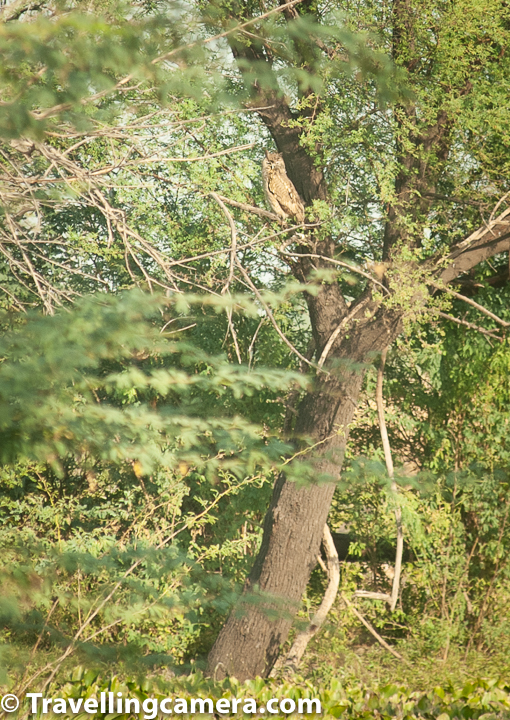 |
When you enter Keoladeo National Park, the Bird Sanctuary at Bharatpur, you may at first feel that you are alone. Indeed, the initial few kilometers can be very quiet. Only when you stand still and carefully watch the bushes and trees that line the main walk that you start noticing movements. At first, it is just the little birds - Bee-eaters, sunbirds, bulbuls, starlings, and munias. But slowly you realize that a more sinister presence looms somewhere. That is when you notice the first Egyptian Vulture (white against a startling blue sky) following your progress, sitting high up in the branches looking down upon you. And then you suddenly spot the entire colony of these yellow-faced raptors perched silently and staring out in a distance.
 |
| Adult Egyptian Vulture - the Indian subspecies |
The colony is at a distance and at first you do not know what you are looking at. You can be excused for mistaking these large birds for any one of the migratory birds that Bharatpur is famous for. We were able to identify the birds through the binoculars that we were lucky to be carrying with us. But even then, we mistook the darker juvenile for a different species. We are, after all, amateur birders. It was only after we returned from the walk that we were able to consult our copy of A Pictorial Field Guide to Birds of India and identify it correctly. On a side note, though this field guide is an excellent book, it is too heavy to carry to the field, especially if you decide to walk the entire way in warm weather.
 |
| Juvenile Egyptian Vulture |
Even though most of these birds are thought to be signs of doom, I find a quiet dignity in their frank curiosity as they observe the world. On this trip we also realized that the birds of prey are almost always the most silent of all birds. They do not fidget or chatter. Songbirds come next. The most talkative of all birds are the migratory birds. They manage to keep up the chatter, trying to talk over each other. I guess this is because of the way these birds lead their lives. While raptors need to take their prey by surprise, migratory birds need to fly long distances in sync and then maintain a co-operative colony.
 |
| The Adult and the Juvenile Egyptian Vultures |
While the vultures were the easiest to spot, the others not so much. In fact, they were quite invisible. The Spotted Owlets, for example, sat hidden in the tree canopy and didn't stir the entire day. We saw them once in the morning and then again on our way out. They sat on the same branch, in the same position without batting an eyelid. Trust me. In fact, if it wasn't for one of the guides who was pointing these out to some tourists, we would have walked right past them. It was mystifying indeed. Right in the morning, all the guides knew where these spotted owlets would be. A little like the tiger pugmarks in Corbett. All guides know where they would be as if by magic.
 |
| Spotted Owlet |
These spotted owlets looked more like stuffed toys. They were round and fluffy and thanks to their stocky appearance would always look like babies. While one Owlet sat alone, two were huddled together. Though they hardly moved throughout the day, I am pretty sure I detected a barely perceptible movement of necks and am convinced that though these owlets were too dignified to appear excited at the appearance of humans, they were unable to completely curb their curiosity.
 |
| Black-Shouldered Kite |
This rather beautiful raptor turned out to be a black-shouldered kite (also known as the black-winged kite). Gliding gracefully overhead, this kite was only visible to us for a few seconds before it vanished inside the tree canopy.
 |
| Dusky Eagle-Owl |
It took us quite some time to locate this Dusky Eagle-Owl. It may take you a few seconds to find it in this photograph too. This rather large owl was at about 150 metes from the walk. We only knew of its presence because of the group of people who had gathered here. And even from this distance, and despite the fact that people were being uncharacteristically quiet, this owl often turned its face towards us and looked at us with its round, orange eyes. Once again there was that restrain in this raptor's curiosity.
 |
| Western Marsh Harrier |
When I look at this picture of a Western Marsh Harrier and that of the black-shouldered kite, I feel that it was a miracle that we were able to identify some of these birds simply from these two shots. The task was definitely made easier by this website: https://avibase.bsc-eoc.org/checklist.jsp?region=INnwrj01&list=howardmoore®ion=INnwrj01&list=howardmoore. I would highly recommend everyone who is planning to visit Keoladeo National Park to go through this list once. It just becomes easier to identify the birds that you will come across.
 | |||
| Spotted Owlet |
One of the very interesting birds that we saw but were unable to click was the Common Kestrel. This is the bird that you often see hovering over a grassland or wetland before it suddenly dives in order to catch an unsuspecting prey on the ground. We saw this bird several times at Keoladeo National Park, but it can also be seen hovering in Noida.
None of these birds are spectacularly colored, like some of the other birds at Keoladeo National Park are. But somehow these birds have a beauty of their own. What they lack in terms of prettiness, they more than make up for it in terms of grace and dignity. It was definitely rewarding to spot these birds of prey at Keoladeo National Park.


.jpg)
Comments